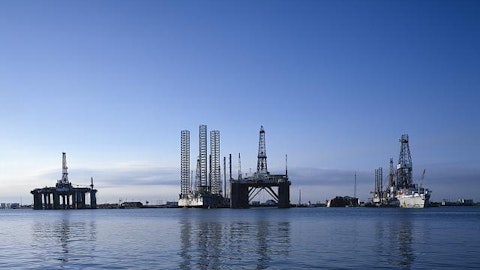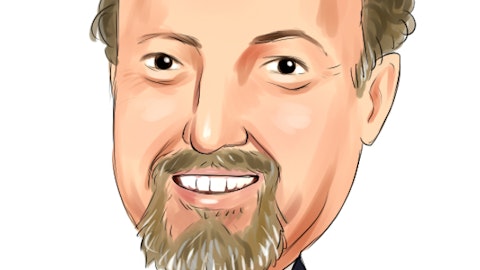Fluor Corporation (NYSE:FLR) Q2 2023 Earnings Call Transcript August 4, 2023
Operator: Good morning, and welcome to Fluor’s Second Quarter 2023 Earnings Conference Call. Today’s call is being recorded. At this time, all participants are in a listen-only mode. A question-and-answer session will follow management’s presentation. A replay of today’s conference call will be available at approximately 10:30 a.m. Eastern Time today accessible on Fluor’s website at investor.fluor.com. The web replay will be available for 30 days. A telephone replay will also be available for seven days through a registration link also accessible on Fluor’s website at investor.fluor.com. At this time for opening remarks, I would like to turn the call over to Jason Landkamer, Head of Investor Relations. Please go ahead, Mr. Landkamer.
Jason Landkamer: Thanks, Regina. Good morning, and welcome to Fluor’s 2023 second quarter earnings call. David Constable, Fluor’s Chairman and Chief Executive Officer; and Joe Brennan, Fluor’s Chief Financial Officer, are with us today. Fluor issued its second quarter earnings release earlier this morning and a slide presentation is posted on our website that we’ll reference while making prepared remarks. Before getting started, I’d like to refer you to our safe harbor note regarding forward-looking statements, which is summarized on slide 2. During today’s presentation, we’ll be making forward-looking statements, which reflect our current analysis of existing trends and information. There is an inherent risk that actual results and experience could differ materially.

Christian Lagerek/Shutterstock.com
You can find a discussion of our risk factors, which could potentially contribute to such differences, in our 2022 Form 10-K, and Form 10-Q, which was filed earlier today. During this call, we will discuss certain non-GAAP financial measures, reconciliations of these amounts to the comparable GAAP measures are reflected in our earnings release, and posted in the Investor Relations section of our website at investor.fluor.com. I’ll now turn the call over to David Constable, Fluor’s Chairman and Chief Executive Officer. David?
David Constable: Thank you, Jason. Good morning, everyone. Thank you for joining us today. Please turn to slide 3. During the second quarter, I visited our New Delhi office and hosted a town hall meeting that was attended by over 1,100 of our Fluor colleagues. It was great to see the vibrancy and enthusiasm of our team, who will continue to play a critical role in supporting our current projects as well as our significant pipeline of growth opportunities worldwide. While in India, I also met with the CEO of Tech Mahindra, to sign a strategic partnership agreement. Tech Mahindra is a leading provider of digital transformation, consulting and business reengineering services. Under the partnership both Fluor and Tech Mahindra, will combine our respective expertise to help support the growing client demand for digital handovers.
The seamless integration and interoperability of data is critical to support professional services teams in driving successful project delivery and optimizing life cycle operations and maintenance costs. I’m looking forward to providing updates on this strategic partnership in future quarters. Now let’s turn to slide 4. Revenue for the second quarter was $3.9 billion, representing our second straight quarter of 20% growth over the prior year. Our increase in revenue was led by Energy Solutions as execution activities accelerate on refinery projects in Mexico mid-scale LNG projects and recently awarded chemicals projects in China. New awards for the quarter were $3.7 billion and on track relative to our full year plan of a book-to-burn ratio of one or greater.
New awards were 70% reimbursable and our total backlog is now $25.5 billion, of which 64% is reimbursable. Margins on new awards continue to be strong, coming in over 200 basis points above our total backlog margin. Our optimism for the future of Fluor is further supported by a robust prospect pipeline. We are currently working on or recently completed FEED and study packages that represent an estimated $300 billion of installed cost high-quality new award prospects. In the near term, we are tracking key EPC and EPCM prospects, totaling approximately $49 billion across the company. Moving to our business segments. Please turn to slide 6. Urban Solutions reported a $76 million profit in the second quarter. Results included a positive forecast adjustment related to a legacy infrastructure project as well as increased execution activities on newly awarded projects.
New awards for the quarter were $2.3 billion and any backlog is now $11.7 billion and 58% reimbursable. Please move to slide 7. In Mining & Metals, we are actively working on a number of front-end studies supporting the advancement of critical minerals production, including two pre-feasibility studies for lithium developments in North America and other lithium project feasibility study in Europe and a metals recycling facility in Europe. We also recently completed engineering services on a major new steel mill in the United States, using electric arc furnace technology and have two additional electric arc furnace projects entering the feasibility study and execution phases. These are just three projects in greenfield technology, which we consider to be a strategic growth market for Fluor.
Near-term prospects in this segment include projects relating to potash, lithium and copper. Moving to slide 8. Our Advanced Technologies & Life Sciences business continues to win new work in an expanding reimbursable growth market. During the quarter, we announced that we received a $574 million award for the first phase of a new life sciences production facility in the Central US. We also won a $487 million expansion for an existing biotech facility with a key client in Denmark. Looking ahead, we are well positioned to expand our existing portfolio of semiconductor work, particularly in the US. I’m also pleased to report that our portfolio of infrastructure projects, including legacy projects, met our forecast expectations for the quarter.
Specific to our legacy infrastructure portfolio, we are starting to see some very positive momentum from our efforts last fall. This included strengthening leadership and execution at the project and management levels, as well as working effectively with our joint venture partners to align our strategy to manage claims. On the Gordie Howe project, Fluor, along with our partners have had a number of successful and productive conversations with the client as it relates to cost and schedule relief, including costs related to COVID. Negotiations are progressing with the client, which should result in a positive path forward by the end of the year. Finally, during the quarter, we booked a $700 million award for the I-35 South project in San Antonio for the Texas Department of Transportation.
This project is a crucial step in our ongoing efforts to enhance the state’s transportation infrastructure and to further support the demand of population growth and business expansion in one of America’s most rapidly developing regions. Moving on to slide 9. Mission Solutions reported segment profit of $40 million for the second quarter, compared to $28 million a year ago. Results for the quarter reflect increased execution activities on a European logistics support project for the Army and our ongoing work to support NuScale’s carbon-free power project. Regarding the protest of our winning bid for the Hanford Tanks integrated disposition contract, we learned that the judge has set aside the award and sent it back to the DOE for corrective action.
While we await the department’s path forward on the acquisition, the incumbent has been extended on the contract for the time being. Fluor continues to be well positioned for Hanford and other future nuclear remediation opportunities with the DOE. Looking ahead, Q3 is shaping up to be an exciting quarter for this group. We recently announced that our joint venture with Amentum was successful in securing the contract for the Portsmouth Gaseous Diffusion plant decontamination and decommissioning contract. This contract has an estimated value of $5.9 billion over a 10-year ordering period and includes potential task orders for up to an additional five years. We expect to book our initial annual portion of this contract in the third quarter. Finally, the request for proposal for Pantex was recently issued.
Fluor was successful in the original bid and is currently working on it’s RFP package, which we expect to submit in September. The revised RFP includes a five-year base period, with three five-year options valued up to $30 billion over 20 years. Moving to Energy Solutions. Please turn to slide 10. Segment profit improved to $89 million from $65 million a year ago. Results reflect the ramp-up of execution activities on refinery projects in Mexico, through our ICA Fluor joint venture. We also had positive forecast adjustments, totaling $74 million on two projects. Q2 results also included a $34 million charge for cost growth and schedule extension on a large upstream legacy project. During the quarter, this project experienced a number of challenges arising from lower-than-anticipated subcontractor productivity, unexpected discovery work and delays from weather and activist protests.
Our new estimated completion date is December. New awards for the quarter totaled $753 million and included an EPC contractor Mitsubishi’s ethylene vinyl, alcohol copolymer facility in the UK, as well as incremental awards on existing LNG projects. Moving to slide 11. During the quarter, we had a number of accomplishments at the LNG Canada project. Last month, we announced that the 215th and final module was delivered to the site. This represents a significant milestone for the project and for the teams that letter fabrication efforts. With the project at 85% complete overall, our efforts now turn to module installation and hookup in advance of pre-commissioning and commissioning activities that will commence next year. In past earnings calls, we’ve discussed our collaborative conversations with the client related to fabrication and construction costs.
We continue to have successful resolution to ongoing variation orders. I’m also pleased to report that as a result of the tremendous effort by our project team, we continue to execute LNGC for our current expectations. Regarding the Phase II expansion, LNG Canada’s five joint venture participants continue to evaluate the time line and scope. For the balance of 2023, we are anticipating some significant new awards. This includes a multibillion-dollar full EPCM award for Dallas Path to Zero ethylene and derivative chemical complex in Canada, the $1.4 billion Salina Cruz refinery in Mexico, nuclear engineering work in Romania and a large chemical project in Europe. Before I turn the call over to Joe, I want to note that our results and accomplishments this quarter reflect notable progress against our corporate strategy and is indicative of our ongoing transformation into one of the leading engineering and construction companies in the world.
With that let me turn the call over to Joe for the financial update. Joe?
Joe Brennan: Thanks, David, and good morning, everyone. Today, I will review our results for the second quarter, provide an update on divestitures and go over key financial outlook assumptions that support our guidance. Please turn to Slide 13. As David mentioned for the second quarter of 2023, revenue of $3.9 billion came in as expected and represented a 20% increase from last year. Revenue for the quarter was driven by the ramp-up of execution activities on several recently awarded projects in Energy Solutions, Urban Solutions and Mission Solutions. This was partially offset by declines in the volume of execution activities for projects, which were completed or nearing completion. Our consolidated segment profit for the quarter was $191 million.
This performance was driven by higher execution activity on new projects as well as positive forecast adjustments on two energy solutions projects and a positive forecast adjustment on a legacy infrastructure project. Adjusted EBITDA for the second quarter was $181 million compared to $68 million a year ago. Our adjusted EPS was $0.76 compared to $0.15 in Q2 of 2022. Our adjusted results for the quarter exclude $52 million for the income effects of FX and the embedded derivative in Mexico. G&A expenses for the quarter were $60 million, up slightly from $45 million a year ago. This was driven higher — by higher performance-based compensation that is expected to be paid in Q1 of 2024. Net interest income for the quarter was $37 million compared to $41 million last quarter and an expense of $1 million a year ago.
Since our outstanding debt is at a fixed rate, I expect we will continue to generate positive net interest income throughout the year with prevailing interest rates on our deposits. New awards of $3.7 billion in the quarter drove our ending backlog balance to $25.5 billion. Based on our current prospect pipeline, we anticipate new awards will roughly approximate our revenue burn for the full year. Moving to Slide 14. Our cash and marketable securities balance for the quarter was $2.1 billion. This excludes cash held by NuScale. Operating cash flow for the quarter was a positive $62 million. We expect this positive cash flow trend to continue for the balance of 2023 which includes approximately $200 million for legacy project cash needs this year.
We anticipate legacy project cash needs will be approximately $250 million in 2024. Finally, I’m pleased to say that during the quarter the DOJ has informed us that it has closed its investigation of the company and does not intend to bring charges. Please turn to Slide 16. We are raising our 2023 adjusted earnings per share guidance to a range of $2 to $2.30 and our adjusted EBITDA guidance to a range of $500 million to $600 million. Our assumptions for 2023 include revenue growth of approximately 10% to 15%, adjusted G&A expense of approximately $45 million per quarter and an effective tax rate of approximately 40%. This may vary depending on the countries in which revenue is generated. We expect tax rates to moderate as revenue in our tax advantage locations start to increase.
Our revised expectations for 2023 full year segment margins are approximately 6% in Energy Solutions, approximately 3% in Urban Solutions and approximately 4% in Mission Solutions. Finally, we also reaffirm our 2026 adjusted EBITDA guidance of $800 million to $950 million as indicated in our earnings release this morning. Operator, we are now ready for our first question.
See also 20 Countries With Highest Rates Of AIDS and 26 Biggest Marijuana Companies in the World.
Q&A Session
Follow Fluor Corp (NYSE:FLR)
Follow Fluor Corp (NYSE:FLR)
Operator: [Operator Instructions] Our first question will come from the line of Jamie Cook with Credit Suisse. Please go ahead.
Jamie Cook: Hi. Good morning. I guess my first question David or Joe, as I think about your guidance the increase in guidance that you provided today what that implies for the back half of the year, I think it implies like at the high-end $0.75 a quarter. So let’s say if you annualize that it’s about $3 in earnings power. And if you annualize our your back half EBITDA — adjusted EBITDA implies like $800 million in EBITDA. So I’m just trying to understand what that means for 2024. Is that a good base that we can think about, or are there projects rolling off in 2023 that would imply, but that’s not a good sort of run rate to think about because that just implies the earnings power for 2024, $3 or $800 million in EBITDA is pretty substantial. And so just any color on that? Thank you. If I’m thinking about that incorrectly? Just the earnings power is greater I guess than I would have thought.
Joe Brennan: Yeah. Thanks for the question, Jamie. I think what we’ve leaned into the last few quarters is that we have been making progress on some of our activities in our infrastructure, our legacy kind of businesses relative to how we recognize cost and then as we look to claw back some of our entitlements through the contract. Some of that is flowing through the Q2 numbers. But I would suggest that that run rate that we’re posting on an adjusted EBITDA basis of $181 million is probably overstated slightly. If I were thinking about run rates, as we continue to onboard new backlog is in that $140 million to $160 million range. And with that we would expect to see a ramp-up from that as your baseline. So, I think I would think about it that way at least for 2023 and again, as we onboard the new backlog that we’re forecasting for the back half of the year, we should start to see that trend in a more positive direction moving forward.
Jamie Cook: Okay. And then just my second question just it sounds like new award prospects for the back half of the year also seems pretty good. So, just Dave how are you thinking about backlog as we exit the year? And then can you give some color? I know the bookings are — the margins in the bookings have been improving. Can you just talk about the terms and conditions of the projects that you’re sort of looking at and how we should think about awards going into backlog — the margins on awards going into backlog relative to where it sits today. Just again trying to understand what the margin power is for 2024? Thank you.
David Constable: Good morning Jamie. Yes, we’ve been really pleased with our ability to increase booking margins on reimbursable work. I guess that’s the kind of the headline is that all this — the majority of our work, I think we’ve got 84% of our prospects right now are reimbursable and they are coming in higher than our expectations, higher than our planned target margins. As I said we’ve — I think we put in the backlog at 200 basis points above what’s in there now in second quarter. So, as we continue to do that the healthy backlog will continue to give us more certainty and predictability as we work that backlog off. And yes we hope to be at a book-to-burn through the year of one or slightly above and that will kind of gives you an idea of where we’ll be at the end of the year for backlog.
But not just on revenue, I think what’s important here is that gross margin that’s coming in higher than expected is also being executed. We are executing. We had this discussion with our risk committee at the Board meeting this week. Since 2020 those projects that have come into backlog are executing at 114% of outsource. So, we’ve got some great earnings power in our execution. It’s all about execution excellence. And when you’ve got that behind you right? And we just really think that it’s going to support that earnings power for us going forward and increase shareholder value for us.
Joe Brennan: Can I — maybe if I can just add to that too Jamie. If you look at what we’ve done with our operating margin guidance for the quarter we have bumped our Energy Solutions and our Mission Solutions numbers for the period. So, we are starting to see that and it is starting to demonstrate in our quarterly postings here. So, we’re starting to see that flow through the backlog in a very positive way which is considering us to readdress our margin guidance. Thanks Jamie.



